Urban Air Mobility:
Airside Planning Considerations for Vertiports
Contributors: Prakash Dikshit, Tom Burkman, Tom Cornell, Jeffrey Jackson, Rich Barone
This LAB Brief is the first in a series on Advanced Air Mobility (AAM) which refers to the collective group of emerging aviation technologies that are anticipated to provide air transportation mobility options for people and cargo in local, urban, and regional environments. The focus of this Brief will be on Urban Air Mobility (UAM), one of the two subtypes of AAM, and specifically the airspace and airside aspects of this emerging form of mobility. Future LAB Briefs will delve into other areas of AAM.
UAM refers to all aerial mobility options in dense urban areas, which includes traditional helicopters and anticipated electric-propulsion aircraft. Helicopters have existed since the early 20th century but they remain on the fringes of mobility options due to the high cost of operation and the significant noise concerns. Recent advances in battery technology have attracted a wave of innovators, engineers, and investors who are interested in bringing electric-propulsion aircraft to the market. There are over 200 electric-propulsion aircraft currently under development around the world, which are anticipated to have lower operating costs and be quieter than helicopters.
Various UAM services are now within reach because some electric-propulsion aircraft manufacturers have agreed with the FAA on the certification requirements for commercial operations. Due to the significant interest from investors, local governments, and manufacturers, several UAM operators have announced new service launches within the next 3-4 years, using electric Vertical Takeoff and Landing (eVTOL) aircraft. Now is the time for cities and local governments to be proactive in setting policy and planning for potential UAM operations in their jurisdictions. NASA has proposed six UAM maturity levels (UML) differentiated by the volume of operations and levels of automation of aircraft operations and air-traffic management.
This article focuses on UML 1 and 2, which are anticipated in the latter half of this decade and early in the next decade. This initial maturity level will have piloted low-density operations in controlled environments. Of the many components required to get UAM services off the ground, the three principal components are the aircraft, the facilities, and the airspace structure and management.
eVTOL aircraft development is making rapid strides, and the current airspace structure and concept of operations will likely be adequate to support operations in UML 1 and 2. Therefore, the planning and development of facilities needs to mature to the level of the other two principal components.
Vertiports are expected to be a combination of upgraded existing heliports and purpose-built new facilities.
Conceptual Rendering of Urban Vertiport
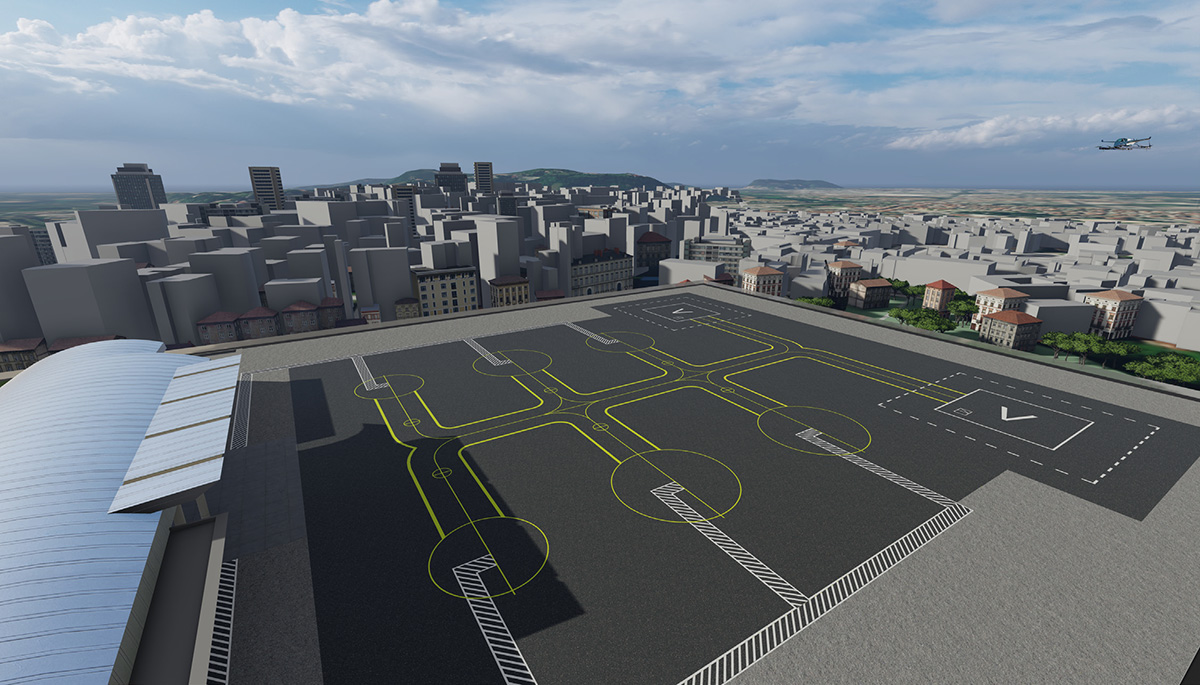
Neither the FAA nor ICAO have published regulations for the planning and design of vertiports. The FAA is working on an Advisory Circular (AC) for vertiport design, but it is likely to be several years before it is published. Similarly, the European Aviation Safety Agency (EASA) has established a task force to develop a Vertiport Design Manual, but no timeline has been provided for its release.
Since the regulatory guidance is lagging behind the technological and commercial advances in the industry, many vertiports are being planned according to the FAA’s AC 150/5390, Heliport Design, and ICAO Annex 14, Vol II, Heliports, due to the similarity between eVTOL aircraft and helicopters.
The latest draft of the FAA’s Heliport Design AC, which is currently out for industry review, clearly states it is not intended for planning facilities to support non-helicopter operations. The FAA is planning to release an Engineering Brief on Vertiport Design in the next 18 months that will serve as interim guidance, but any facilities developed for UAM operations using the heliport planning criteria are proceeding at risk.
Guidance for Vertiport Airside Planning
There are many important aspects that cities, local authorities, and existing airport operators should consider as they plan for vertiports in their jurisdictions. Landrum & Brown has a long history of planning heliports for cities, hospitals, and independent operators. Leveraging its technical and global experience, L&B has addressed some of the common questions about vertiport planning and development. Even though many airports, both commercial and general aviation, have helipads, this article draws parallels between standalone heliports in urban environments and vertiports as they are most similar in their planning, development, and operating considerations.
What certification and planning regulations apply?
The FAA and EASA do not have certification requirements for standalone heliports, unlike airports, which go through an intensive certification process before commencing operations. The primary reason for the FAA and EASA to exempt heliports from requiring certification is they serve very few scheduled air transport operations.
Initial UAM operator models are based on point-to-point on-demand service, but scheduled service may be offered in the future that may trigger new certification requirements.
Aviation regulators of ICAO member countries may require compliance with design guidelines specified in ICAO Annex 14, but in the U.S., the FAA only has direct regulatory oversight over heliports that accept FAA grants. Currently, only three of the 6,000 heliports in the U.S. have accepted FAA grants and are required to adhere to the Heliport Design AC. The FAA does not have direct regulatory oversight to enforce the Heliport Design AC, but local and state laws may require heliport operators in their jurisdictions to comply with the FAA AC. In fact, local laws may include additional or more stringent planning and operational criteria that possibly make it inconducive for the development of new vertiports. For example, lawmakers have introduced bill H.R. 4880, Improving Helicopter Safety Act of 2019, that prohibits helicopter flights over any city with a population of eight million people. This bill has not passed the House; however, similar legislation could be introduced by state and local governments. Therefore, vertiport developers should engage extensively with local governments during the planning process to determine the applicability of local laws.
Who will use the facility?
New vertiport development could be sponsored by cities, independent infrastructure operators, or be purpose-built for specific UAM operators. Facilities that are exclusive to specific operators will likely only serve a few aircraft types and could be optimized to take advantage of specific aircraft characteristics. On the other hand, approval of operator-exclusive vertiports could result in concerns such as proliferation of vertiports with competing requirements, inefficient resource utilization due to disaggregation of facilities, and the risk of expensive abandoned facilities Common-use facilities that cater to multiple operators with a variety of aircraft types and should be planned for a critical aircraft type, which can be either one aircraft or a composite of various aircraft types.
The FAA has indicated that the Vertiport Design AC may include performance-based categorization for vertiports, which may help narrow the number of aircraft types to be considered during the planning process.
Assuming similar regulations as helicopters, it will be the Prior-Permission-Required vertiport owner/operator’s responsibility that pilots of all authorized operations are thoroughly familiar with the facility, its operational procedures, and any other facility limitations. Therefore, common-use vertiport owner/operator’s should balance flexibility with practicality during the planning process, so the operational or aircraft type restrictions are factored into the flight approval process. In addition to flexibility for the proposed use case, local governments must ensure continued long-term viability of facilities by balancing immediate requirements with future adaptability. Vertiport planners may also want to consider emergency situations beyond the proposed use case, such as the National Guard, Fire, or Law Enforcement. For example, L&B typically considers the Sikorsky UH-60 Black Hawk helicopter as a potential user when planning heliports, even if it is only intended for passenger or medical use.
What are the airside components of a vertiport?
The primary airside components of any vertiport will be the Final Approach and Take-Off Area (FATO), the Touchdown and Lift-Off Area (TLOF), the parking positions, and taxiways.
- The FATO is the area on which the pilot completes the final phase of approach transitioning to hover or landing, and the area on which the pilot transitions from stationary or hover to take-off.
- The TLOF is the load-bearing paved area on which the aircraft performs a touchdown or lift-off. The TLOF is typically centered in the middle of the FATO but could be located outside it.
- The Parking Position is an area where an aircraft is temporarily parked to avoid blocking the FATO and TLOF. Passenger operations and charging will be completed at the Parking Position.
- Aircraft need to taxi between the FATO and the parking position using taxiways. Vertiports need to plan for hover-taxi because most eVTOL aircraft do not have wheels for ground-taxi.
- These elements are planned based on the physical characteristics of the aircraft to be served. For helicopters, typical parameters considered are the maximum weight, the overall length, the rotor diameter, the tail rotor arc radius, and the undercarriage dimensions.
These elements are planned based on the physical characteristics of the aircraft to be served. For helicopters, typical parameters considered are the maximum weight, the overall length, the rotor diameter, the tail rotor arc radius, and the undercarriage dimensions.
eVOTL Aircraft Under Development
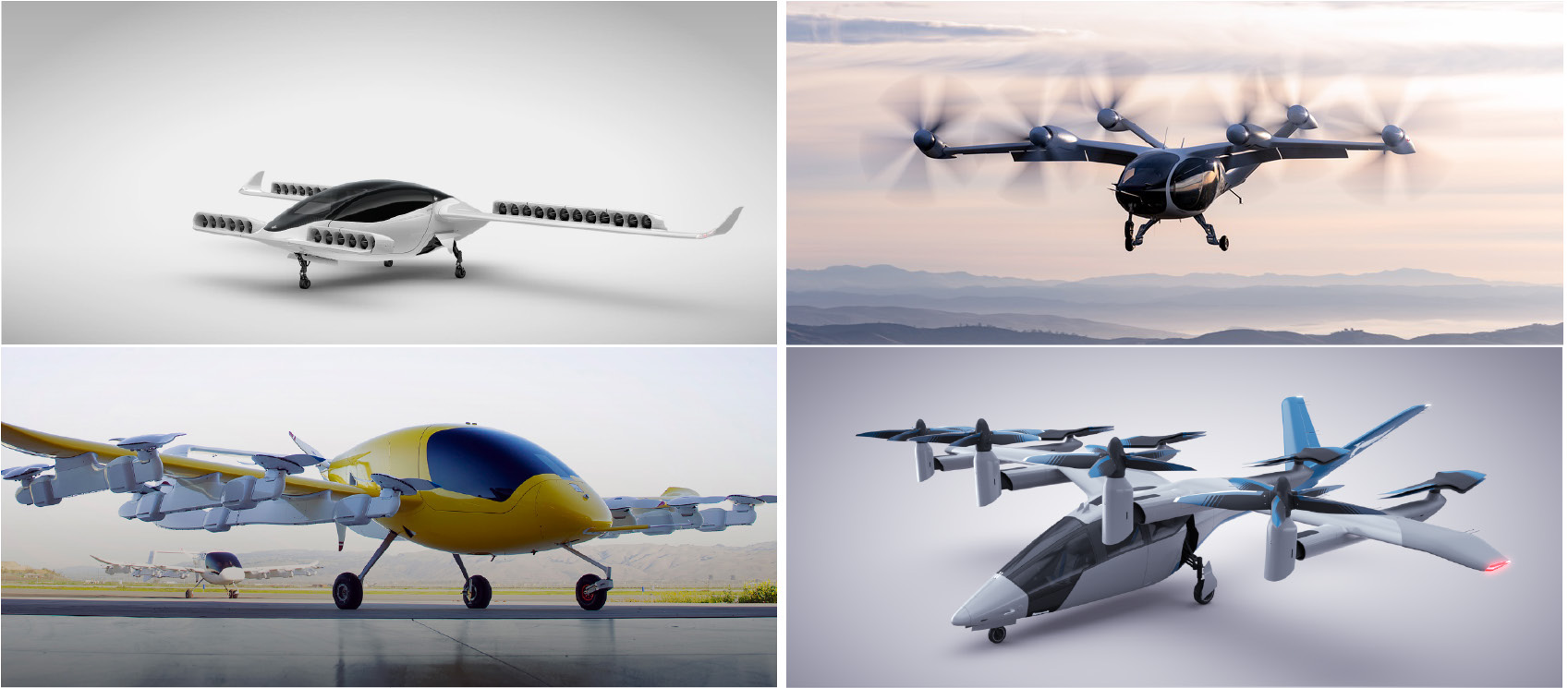
Sources: (clockwise from top left): Lilium, Joby Aviation, Vertical Aerospace, and Wisk Aero
The Design Helicopter for a facility is a single or composite helicopter that reflects the most demanding values for each critical parameter. eVTOL aircraft not only vary in design, but also in the underlying mechanism to generate vertical and forward flight.
Identifying the critical dimensions for these various designs and adapting planning can be challenging and is a source of significant risk for infrastructure developers following the Heliport AC.
What is the typical layout?
Several possible layout configurations are possible, yet most vertiports are likely to resemble high-volume transport heliports that have one or more FATOs with co-located TLOFs, and a separate parking area with multiple parking positions as shown in the diagram below. Transport heliports are only allowed to use “turn-around’” parking positions and not ”back-out” parking positions. This one-size-fits-all approach may not be suitable for vertiports. One of the primary safety concerns with rotorcraft is passengers walking into the main or tail rotor. Due to the different underlying technologies, each eVTOL aircraft type may require a separate passenger safety risk assessment before determining an appropriate stand layout.
If initial operational volume is managed with a single FATO, new vertiports should plan for expansion to multiple FATOs to accommodate future demand growth.
Current heliport regulations require FATOs with simultaneous operations to be planned with at least 200 ft (60 m) of lateral separation. These requirements could vary for vertiports depending on the aircraft dimensions, procedures, and layout. The capacity of a FATO, without passenger loading/unloading or charging, is anticipated to be around 20 operations an hour. It is recommended that new vertiports be planned with separate arrival and departure FATOs to maximize capacity.
Each component of the vertiport, such as the FATO, the taxiways, the number of parking positions, and the charging points, will have its own respective capacity. The capacity of the vertiport will depend on the layout and the concept of operations and will be equal to the capacity of the component with the lowest capacity. For example, even if the vertiport has space for multiple FATOs, the airspace may not be able to support a higher volume of operation. Therefore, L&B recommends a holistic planning approach to avoid incongruous facility development.
What airspace procedures are needed?
The FATO only refers to the area over which the pilot completes the final phase of approach or the initial phase of departure.
The approach or departure path, which extends well beyond the FATO, connects the vertiport to the wider airspace. Vertiports should be planned, like heliports, with two approach/departure paths that are clear of obstructions. Ideally, one path is aligned with the primary wind direction and the secondary path will provide adequate wind coverage to avoid operating with strong crosswinds.
Today, the majority of civilian helicopter operations are conducted under visual conditions in good weather. It is anticipated that initial UAM services will have similar limitations, and it is envisioned that pilots will likely fly GPS-based instrument procedures under visual flight rules.
The design and approval process for new procedures, especially in dense urban areas, could take many months. Therefore, vertiports and heliports without existing instrument procedures should plan accordingly to avoid delays in commencement of services.
Can you operate near Airports?
Prior to being sold to Joby Aviation, Uber Elevate planned to include airports in the initial network of vertiports in every launch city because airports were likely to be a critical aspect of their initial and future UAM network.
Vertiports on or near airports are likely to be one of the initial nodes in any UAM operator’s network. The primary challenge is siting the vertiport without impacting airport operations. Some operators have suggested an airside facility; however, the safety and security requirements for such an operation are likely to be prohibitive, and it is more likely that vertiports will be located landside with secure airside access. In addition to the imaginary protective surfaces for airports defined in Part 77, UAM operations also need to stay clear of One-Engine Inoperative (OEI) flight procedures from air carrier runways. This could add further constraints to the vertiport siting process.
While sharing airspace when operating away from airports is challenging for UAM operators, it is potentially easier due to the anticipated vertical segregation between commercial aircraft and UAM aircraft. In comparison, operating near airports, where commercial aircraft are operating at similar altitudes, will require more coordination and resolution of operational impacts. For example, it is anticipated that UAM operations near airports are more likely to trigger Traffic Collision Avoidance System alerts in fixed-wing aircraft.
Conventional Transport Heliport Layout
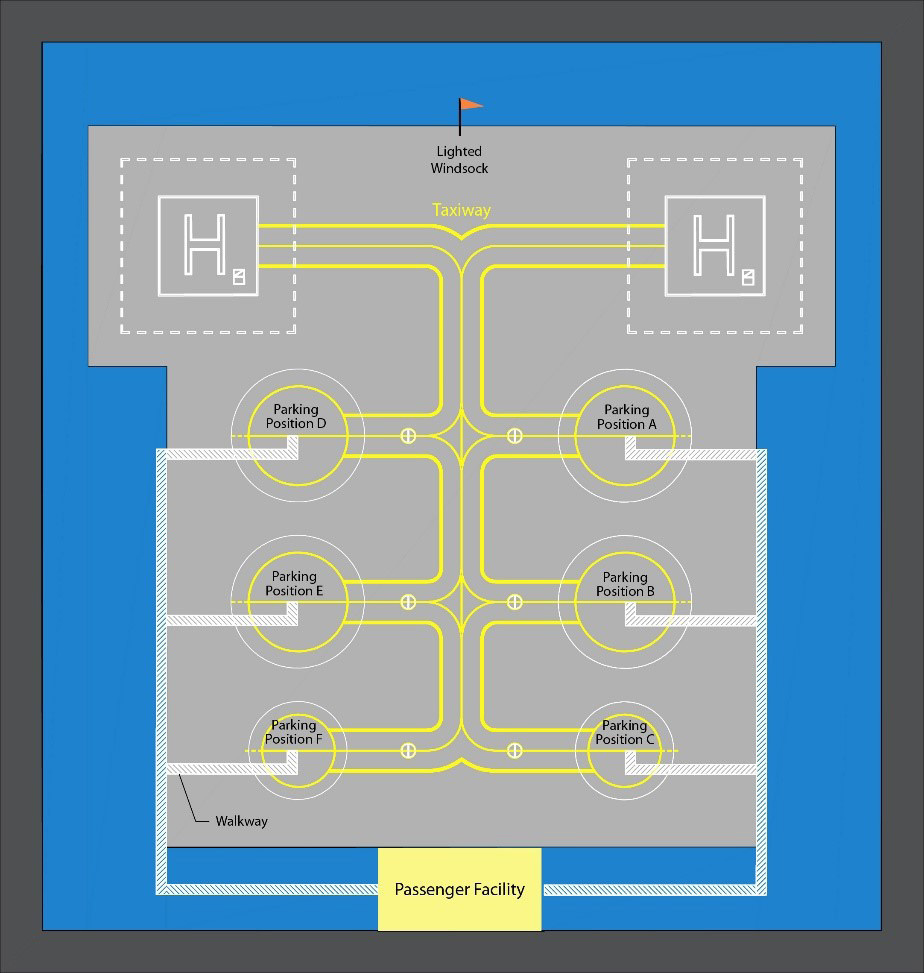
How to manage obstacles and land use?
It is envisioned that vertiports will use instrument approaches and will have to comply with 14 CFR Part 77, which defines the imaginary surfaces that determine if any nearby objects present a hazard to operations.
The image to the right illustrates the approach/departure surface and the transitional surface for a heliport. The surfaces should be clear of any penetrations unless the penetrations are deemed not to be a hazard by the FAA. The surfaces should be clear of any penetrations unless the penetrations are deemed not to be a hazard by the FAA.
Penetrations could be mitigated by realigning the approach/departure paths, or removal, lowering, or lighting of the penetrating object.
Vertiports are likely to require similar surfaces to be protected even though performance characteristics of eVTOL aircraft may require different dimensions and slopes for these surfaces.
Example of Protected Surfaces for Heliports
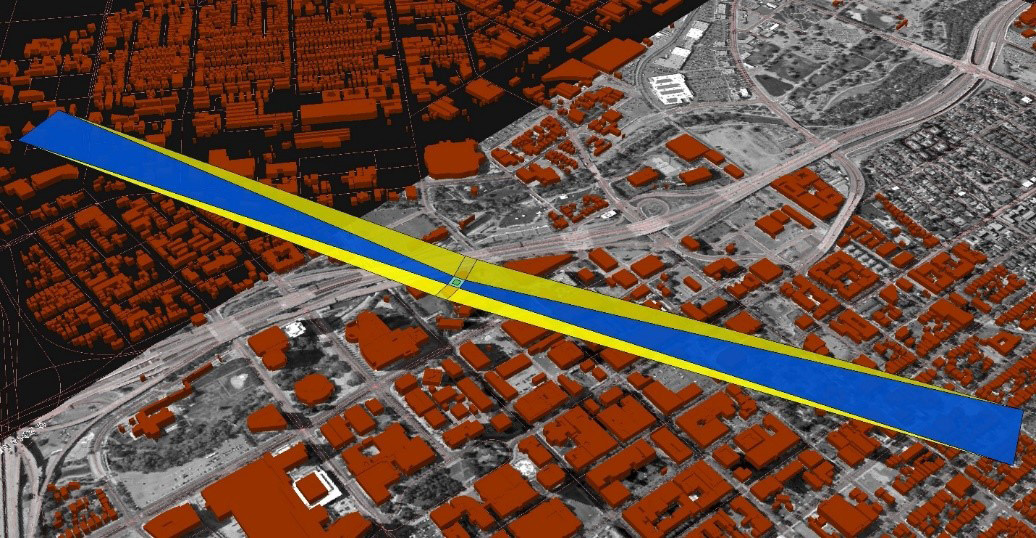
There is limited data available on the performance characteristics of the various eVTOL aircraft under development, which could impact the slope and dimension requirements for these protected surfaces.
Therefore, planning and siting vertiports based on helicopter protected surfaces represents a major risk to vertiport operations. The facility planner needs to strike a balance between the flexibility to accommodate multiple aircraft types, and the ability to mitigate potential obstructions.
Similar to the Heliport Protection Zone (HPZ), the land area immediately off the end of the FATO and under the approach/departure paths should be protected to ensure long-term viability of vertiport operations. For transport heliports, the HPZ extends 400 ft (122m) from the edge of the FATO as shown by the orange area in the image on the prior page. This protected area is intended to manage incompatible land uses such as residential developments and places of assembly directly under the flight paths but implementing such an area for vertiports may prove challenging in urban environments.
The protected areas and imaginary surfaces should be clearly defined during the planning process, and local municipalities would likely control land use in these areas and limit building heights through the use of zoning. Avigation easements may also be used to prevent encroachments of the protected surfaces.
How to manage noise impacts?
A major concern for helicopter operations is the noise exposure, which plays an important role in the approval process for heliports. The purple area in the adjoining image illustrates the area where the noise level of an arriving helicopter would be higher than the sound level of normal speech.
Even though eVTOL aircraft are anticipated to be quieter, reportedly as much as 15 dB for some aircraft, neighboring communities are typically averse to overflights even if the noise is minimal.
Through decades of experience supporting noise offices at airports and evaluating noise surrounding aviation facilities, L&B has observed for neighboring communities that “seeing-is-hearing.”
Therefore, it is critical for any noise and community acceptance concerns to be addressed during the planning process. As needed, local governments may proactively issue noise ordinances, which restrict the total number of operations per day at a facility or along particular flight paths to limit the adverse impact on neighboring communities. Noise regulations should factor into the vertiport site selection process, and the development of flight paths. As a global leader in aviation environmental assessments, L&B anticipates that state and federal environmental approvals may be required prior to construction of the facility.
Example of Noise Contour for a Single Helicopter Operation
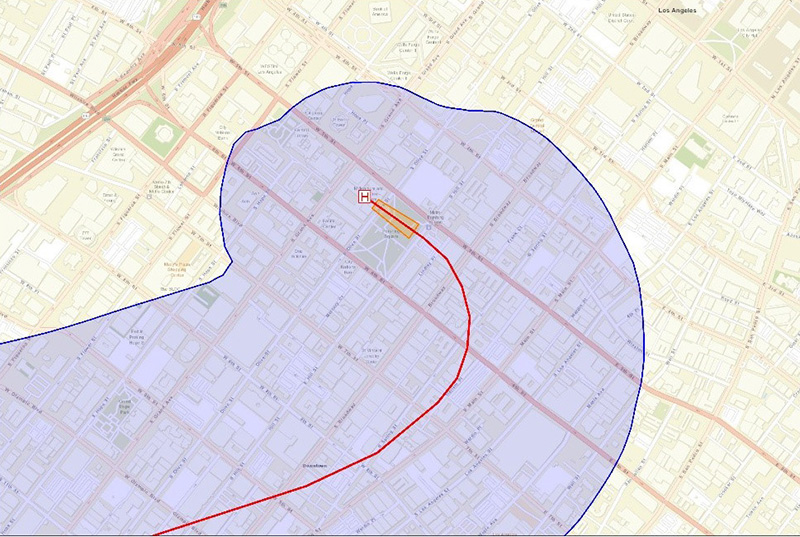
What utilities are needed?
Vertical takeoff and landing operations are high-energy maneuvers that can drain batteries quickly. Therefore, the primary utility need for eVTOL aircraft will be charging stations to recharge their batteries potentially after every flight. The power requirements for charging the aircraft are expected to increase from 1 MW to support a few operations an hour to several MW with increasing operations. Vertiports with a high volume of operations will need either a direct connection to the electrical grid or a dedicated substation to support the electricity demand. The estimated cost of providing electrical connections to the grid is $1M/mile, so this should be an important consideration when siting vertiports.
The National Fire Protection Association’s (NFPA) 418, Standard for Heliports, provides fire safety standards for heliports. Fires related to electric charging equipment or batteries have different ignition and combustion characteristics compared to traditional jet fuel. Therefore, vertiports may require additional or more stringent safety standards including different equipment, training, physical clearances, and construction materials compared to the current standards for heliports.
Other Considerations
There are various aspects of UAM and vertiport planning, operations and design that were not covered in this Brief. Some of these other considerations will be covered in future LAB Briefs, several of them are as follows:
Structure: Vertiports planned on top of existing structures will add significant weight not only due to the pavement requirements, but also the additional utilities needed to support operations.
Passenger Facilities: Passenger facilities should be sized to support peak-hour demand, but several questions require further evaluation. Will these facilities include passenger screening? What would be the passenger baggage allowance, and would these bags be screened? At elevated vertiports, will existing vertical circulation be adequate to support the increased demand due to UAM services?
Landside: In most cases, passengers will still need to complete the “last-mile” of their trip after arriving at the vertiport. Therefore, vertiports must be planned with expedient access to the street and connecting modes of transportation. Will the landside infrastructure such as roads, parking, curbs, and sidewalks be able to accommodate the additional volume of people due to vertiport operations? Could the facility be co-located with a multi-modal hub, so passengers have a seamless experience?
The introduction of UAM operations is exciting, but the long-term success of these operations will depend on the thoroughness with which the facilities are planned. This requires regulators and operators to take an innovative and holistic approach that balances various competing objectives to develop infrastructure that will foster the growth of UAM services.
1 https://www.aviationtoday.com/2021/02/09/joby-agrees-evtol-certification-requirements-faa/
2 UAM Vision Concept of Operations UML-4 Overview, December 18th, 2020
3 NASA AAM: Community Integration Working Group – Vertiport Series Kickoff Webinar, April 1st, 2021
4 NASA AAM: Community Integration Working Group – Heliport Design AC Webinar, February 4th, 2021
5 https://www.congress.gov/bill/116th-congress/house-bill/4880
6 NASA AAM: Community Integration Working Group – Vertiport Series Kickoff Webinar, April 1st, 2021
7 https://www.forbes.com/sites/jeremybogaisky/2019/06/12/uber-snags-airport-landing-pads-for-its-air-taxis-and-a-partner-to-run-its-skyports/
What is the L&B LAB?
The LAB is Landrum & Brown’s research and development unit. Our mission is to harness decades worth of industry knowledge and expertise to develop innovative solutions that support our clients along with promoting industry thought leadership.
This document was prepared by Landrum & Brown, Inc. | Richard.Barone@landrumbrown.com
Sign up to receive our next L&B LAB in your inbox!




